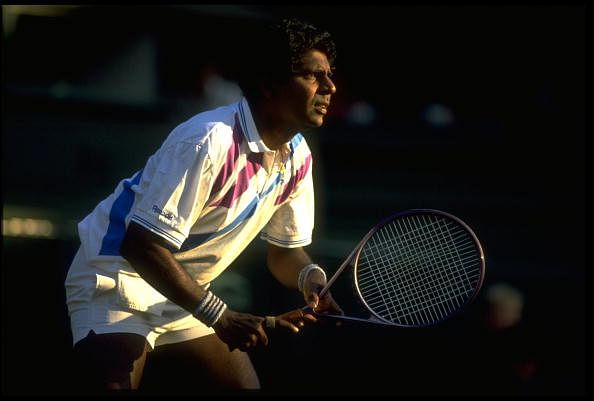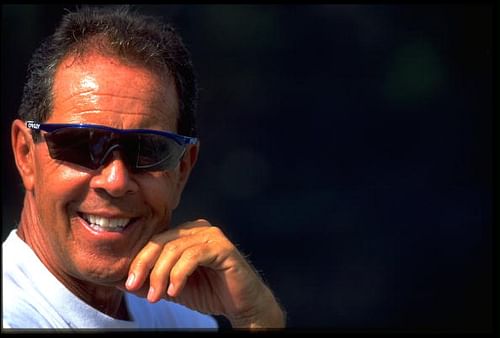
Why "two" is better than "one" in Indian tennis
Midway through the 20th century, an unknown lad from India was making waves on the tennis court with his distinctive style of tennis, a style that was based less on power and more on consistent stroke-play. Ramanathan Krishnan was the lad, who carved a niche for himself in the sport, becoming the first Asian to capture the Wimbledon junior title, at a time when the word ‘tennis’ was synonymous with the West. He went on to scale greater heights, reaching the semifinals of Wimbledon twice, and even possessed a world ranking of No. 3 in 1959, permanently etching his name in Indian tennis. He amassed 50 wins in Davis Cup matches as a singles player, losing only 19 times.

Vijay Amritraj – one of the pioneers of Indian tennis
Vijay Amritraj was another Indian who showed a lot of promise and reached a career-high world ranking of 16 in 1980, capturing 16 titles through his career, and compiled a respectable 391-304 record in his singles career. His greatest achievement on the tennis court is the 5-6 head-to-head record against Jimmy Connors – no mean feat against one of the finest-ever players in tennis.
But ever since Amritraj hung up his racquet after a glittering career, Indian tennis players have failed to impress on the singles front. Leander Paes had a stirring start to his singles career, becoming No. 1 in the junior rankings. He even won an Olympic bronze at Atlanta in 1996. But he cut short his fledgling singles career to focus on doubles, a decision that has catapulted him as a household name in the doubles circuit. Somdev Devvarman also showed a lot of promise at the start of his career but has since flattered to deceive and is currently the 90th-ranked player in the world.
Sania Mirza was once ranked as high as No. 27 in the world and even received a seeding at Wimbledon. She has defeated Marion Bartoli and Svetlana Kuznetsova in her singles career. But there has not been much cheer on the singles front for Saina in the past couple of years, and she seems destined to remain a doubles specialist in the remaining years of her career.
Why has Indian tennis generated a plethora of excellent doubles players but has failed to produce a quality singles player in recent times?
The answer to this question has two major aspects.
Lack of facilities

Nick Bollettieri – Shaping up the careers of many tennis stars
Honing your skills in singles requires only two players to be present on the court – the player and his/her sparring partner.
But this can be a rarity in Indian tennis courts as the sheer population is a strong deterrent to pursuing a career in singles. When Ramanathan Krishnan was denied permission to play at a local club, his father built a makeshift tennis court near their house, thus ensuring that Krishnan had exclusive playing space. But with the burgeoning population, tennis instructors have tried to capitalize on the increasing turnout of children, accommodating four (or sometimes even more) players on a single court. This does not bode well for the career of a singles aspirant as he/she needs to be able to use the full length of the court in order to become a complete player.
India’s lack of exclusive tennis academies has also contributed to the dearth of good singles players. In European countries and in USA, there exist tennis academies where players reside full time and hone their skills. Their academic curriculum is woven into their tennis program, thus ensuring that the students enjoy the best of both worlds. The famous IMG Bollettieri Tennis Academy based out of Florida is one such academy and has seen many of its graduates become the finest tennis players in the world. Andre Agassi, Monica Seles, the Williams sisters and Maria Sharapova are some of the names who have come through the academy, which is run by the famous American-Italian tennis coach Nick Bollettieri, who has a knack for spotting precocious talent.
In India, more emphasis is driven towards academics and the lack of sports scholarships and the paucity of such academies is a major reason as to why India hasn’t produced a quality singles player for a long time.
Doubles is relatively easier to play

Leander Paes of India stands on the podium after winning a bronze at Atlanta ’96
Playing singles is not that easy, for it requires an all-round game. Every aspect of your game has to be fine-tuned if you desire to be a world-beater in singles. Covering the court, possessing powerful groundstrokes, being adept at the net – these are some of the skills that must be in your repertoire for you to prosper as a singles player.
Looking at some of the current generation of Indian tennis players, most of them possess great skills in certain aspects of the game but lack an all-round game to compete in the singles fray.
Rohan Bopanna’s booming serves are his bread and butter, but outside of them, his groundstrokes have lots of room to improve.
Mahesh Bhupathi is not known for his quickness on the court; his brilliant play at the net ensures that he can be an excellent doubles player, but not a great singles player.
Sania Mirza is a shadow of what she was once, and so has shifted her attention to doubles and mixed doubles, thus resulting in her capturing two Grand Slam titles, both with Bhupathi.
Leander Paes had the skill-set to become a successful singles player, but did not possess the temperament that personified the top tennis players. Paes was always a livewire on the court and his impatient tendencies sometimes made it difficult for him to hit the ball the way he would have liked. But this proved to be a boon in disguise as his style was tailor-made for the frenetic play of doubles and Paes has become one of the most successful doubles players in tennis history, winning 53 titles till date.
In totality, doubles masks certain deficiencies in your game, deficiencies that can be nullified by the presence of a partner possessing the same aspects that elude your game. Singles on the other hand is a different ball game altogether and requires different skill-sets. It requires you to be on the top of your game at all times, for there won’t be a partner to rescue you or watch your back.
The modern singles game is mostly focused on playing from the baseline, with serve-and-volley becoming a thing of history after Pete Sampras’ retirement. And playing from the baseline is quite an arduous task as it requires extensive running from one side of the court to another. Doubles, on the other hand, requires you to be responsible only for one half of the court.
Singles can take its toll on a player’s body as the workload has to be entirely shouldered by the player singly, thus dissuading many Indians from taking it up.